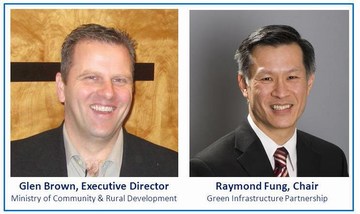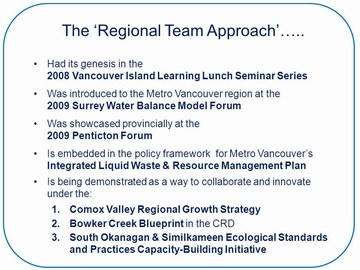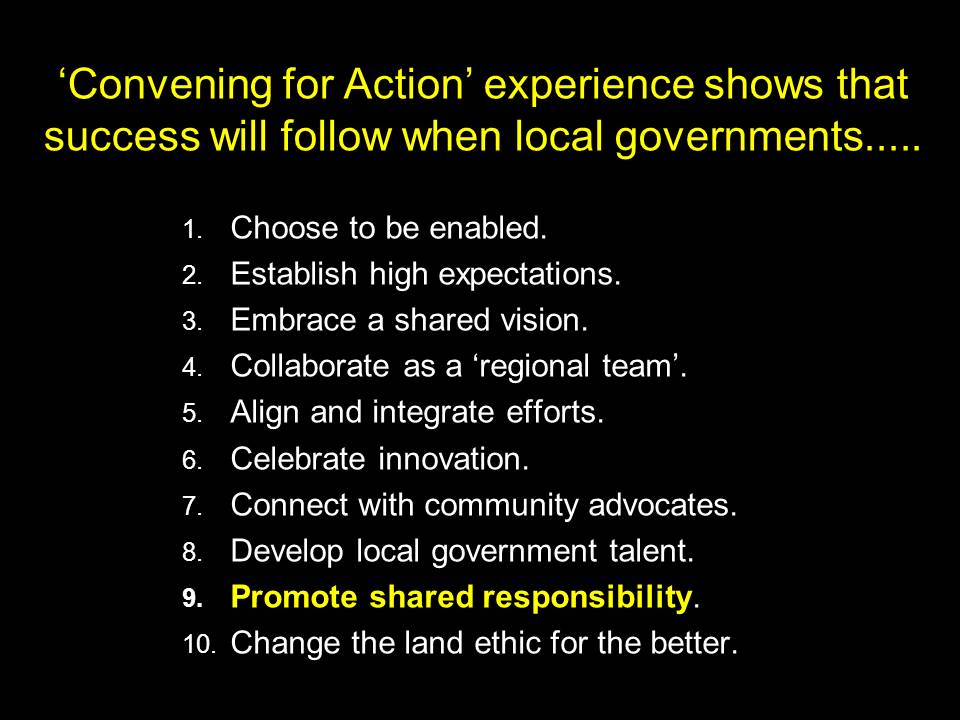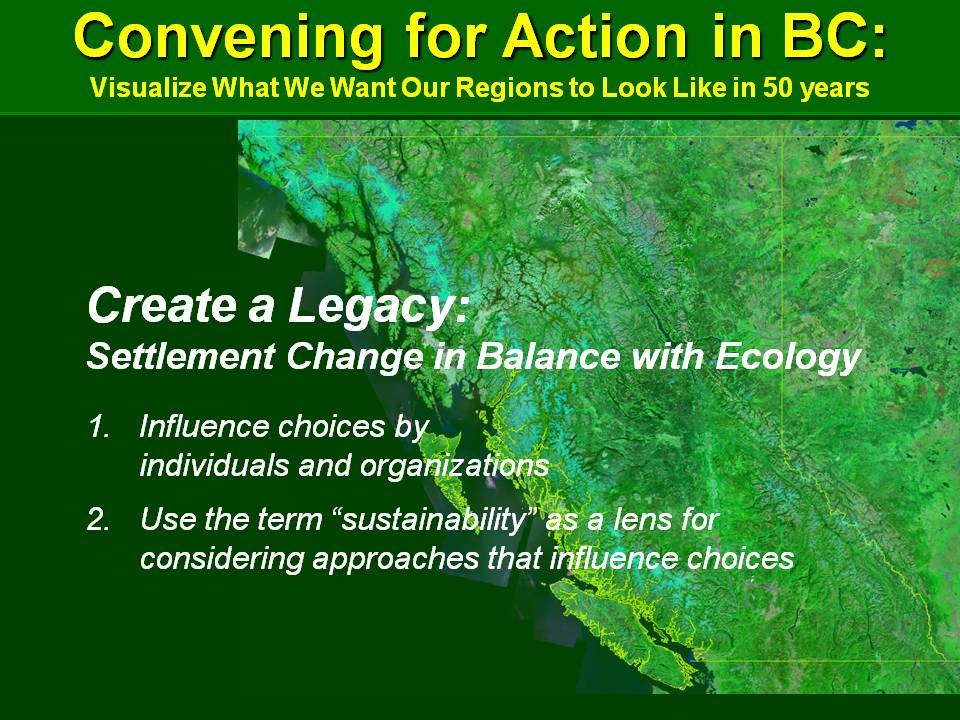Forging Gold Medal Standards for Urban Watershed Protection and Restoration in British Columbia
Convening for Action in British Columbia
The formal rollout of Beyond the Guidebook 2010: Implementing a New Culture for Urban Watershed Protection and Restoration in British Columbia commenced on September 27th at the 2010 annual convention of local governments, held in Whistler. The convention theme was Forging Gold Medal Standards in keeping with the Olympic spirit of the Whistler venue.
Glen Brown and Ray Fung represented the provincial and local government perspectives, respectively, in delivering an integrated presentation to a packed study session (180 attendees). They spoke on behalf of the “convening for action” partnership that is responsible for Beyond the Guidebook 2010, released under the umbrella of the Water Sustainability Action Plan for British Columbia.
To Learn More:
 To view the storyline for UBCM, click on Integrated presentation by Glen Brown and Ray Fung at the 2010 UBCM Convention to download their PowerPoint.
To view the storyline for UBCM, click on Integrated presentation by Glen Brown and Ray Fung at the 2010 UBCM Convention to download their PowerPoint.
Historical Context
In October 1997, a focus group workshop convened by the Union of British Columbia Municipalities set in motion a chain of actions that culminated in the Province producing Stormwater Planning: A Guidebook for British Columbia released in June 2002.
Next, Beyond the Guidebook 2007 set the stage for defining water sustainability as an outcome of green infrastructure policies and practices. Now, Beyond the Guidebook 2010 connects the dots between RAINwater Management and Drought Management and shows how to achieve water sustainability through outcome-oriented watershed plans.
“A decade ago, we made a conscious decision to follow an educational rather than prescriptive path in BC. We realized that changing the way we develop land depends on establishing higher expectations and challenging practitioners to embrace shared responsibility,” stated Glen Brown.

Collaboration, Partnerships and Alignment
The Province of British Columbia has provided a ‘design with nature’ policy framework that enables local governments to build and/or rebuild communities in balance with ecology. A key message in Beyond the Guidebook 2010 is that the future desired by all will be created through alignment of federal, provincial and local policies and actions.
Regional Team Approach
“The philosophy behind the Action Plan is quite simple: bring local and regional stakeholders together where there is a desire and energy to make some form of change,” explained Glen Brown when he elaborated on the ‘regional team approach’.
“As we move forward with the Action Plan, it is making sure that we provide the people on the ground with the tools and resources that they need to help support action at the local level.”
“A top-down approach does not work. It is all about being bottom-up… that is to say, the regional team approach. When a community shows interest or a desire to move something forward, that is when we mobilize. The Action Plan purpose is to engage, listen, understand and support the local interests in moving forward. That is where we have been successful.”
Link to YouTube Video:
To view a 3-minute video clip of Glen Brown elaborating on the ‘regional team appoach’, click here.
And, To Learn More:
Click on Living Water Smart & Building Greener Communities: Implementing a ‘regional team approach’ in British Columbia to download a document that addresses this question: How do we simultaneously work together as staff within a municipality and as a region AND externally with the stewardship sector, developers and other private sector players, to ensure we implement sustainable approaches to development?

Embracing Shared Responsibility Leads to Outcome-Oriented Actions
The case study experience presented in Beyond the Guidebook 2010 shows that a new land ethic is taking root in British Columbia. Changing the culture requires a process. This takes time to complete. There is no short-cut; however, lessons learned by those who have done it can help those who want to do it.
Ten Guiding Principles
Beyond the Guidebook 2010 synthesized a set of ten guiding principles that provide a framework for a successful local government implementation process. Ray Fung spoke to these principles in his part of the integrated presentation.
“There are a lot of times when we in local government like to blame or put on senior governments the responsibility to provide the framework for doing something…but there are things that we in local government can do. We need to choose to be enabled,” stated Ray Fung.
“So, what we mean by shared responsibility is that everyone has a role, and everyone can act…. all levels of government, developers, regulators, bureaucrats, consultants, planners, engineers…. we all have a role.”
Link to YouTube Video:
To view a 90-second video clip of Ray Fung speaking about Guiding Principle #9, Promote Shared Responsibility, click here.
Shared Responsibility Matrix
Shared responsibility is a foundation piece for Beyond the Guidebook 2010. The law and policy component of the Outreach & Continuing Education Program described in the document produced a decision support tool that was branded as the Shared Responsibility Matrix.
Between 2007 and the end of 2009, the Matrix evolved from a set of generic “what we would like to do” questions that were framed through the eyes of practitioners in local government.
To Learn More:
 Click on Shared Responsibility in British Columbia: Application of Bill 27 to achieve Water OUT = Water IN to read a story and access a YouTube video clip of Susan Rutherford of West Coast Environmental Law Foundation explaining the Matrix at the 2009 Comox Valley Learning Lunch Series.
Click on Shared Responsibility in British Columbia: Application of Bill 27 to achieve Water OUT = Water IN to read a story and access a YouTube video clip of Susan Rutherford of West Coast Environmental Law Foundation explaining the Matrix at the 2009 Comox Valley Learning Lunch Series.
Beyond the Guidebook 2010
Released in June, Beyond the Guidebook 2010 is the story of what has been accomplished on the ground over the past decade. It demonstrates that the practitioner culture is changing as outcome of collaboration, partnerships and alignment. It provides local governments with ‘how to’ guidance for developing outcome-oriented urban watershed plans.
Links to Other Stories about UBCM Rollout
- Forging Gold Medal Standards: Water Sustainability Action Plan has centre stage at UBCM Annual Convention — We will use this coming together of BC’s local leaders to share and learn from each other’s experiences, and gain ideas to move our own communities forward.
- Rollout of ‘Beyond the Guidebook 2010’ will commence at UBCM Annual Convention on September 27 — Beyond the Guidebook 2010 is about implementing a new culture for urban watershed protection and restoration. It speaks to the convention theme, Forging Gold Medal Standards, because 2010 is a year that will not soon be forgotten in British Columbia.
- Climate Change Adaptation: UBCM study session on sustainability planning and practice has water-centric emphasis — With local governments increasingly adopting integrated sustainability planning approaches, there is a greater need to develop and strengthen collaborative partnerships amongst all orders of government in environmental management.
- 2010 UBCM Annual Convention provides forum for reporting out on implementation success of Water Sustainability Action Plan — The 2003 Annual Convention initiated and provided high-level endorsement for an Outreach and Continuing Education Program that promotes a ‘water-centric’ approach to community planning and development.
- “Forging Gold Medal Standards will be the theme when BC’s local governments gather in Whistler in September — The 2010 UBCM Convention is set to take place in beautiful Whistler, BC. This is a place that is synonymous with high-level achievement. Now is the time to apply the momentum of these gold medal achievements to local government success.
- A crucially important message in Beyond the Guidebook 2010: “We now have the tools and experience to design with nature” — So many in local government are searching for the magical ‘silver bullet’to resolve watershed issues and challenges. Yet soil, vegetation and trees can do more for our watersheds than decades of planning, consulting and complicated engineering design will ever achieve.





